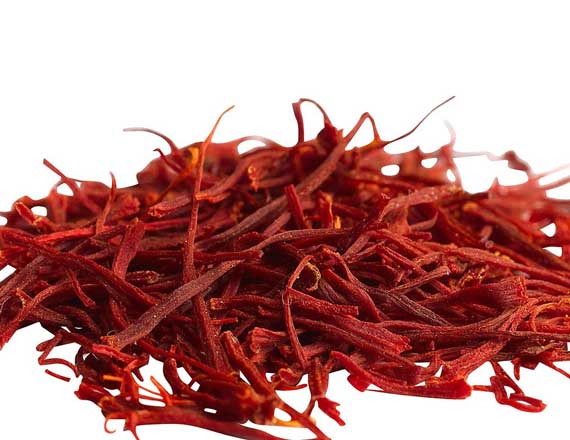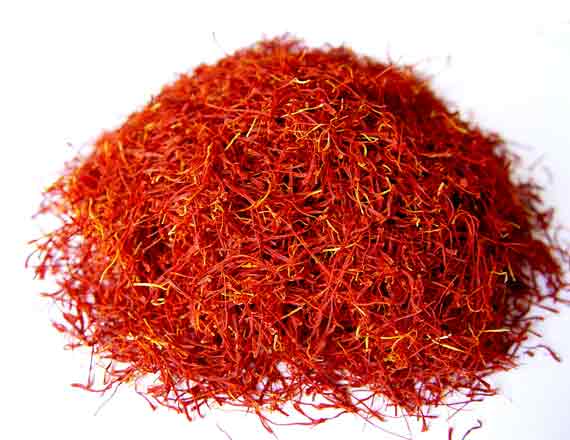|
Types of saffron
|
Negin Saffron
The highest quality of the saffron –threads is referred to as “Negin”.
Negin Saffron belongs to a new variety of saffron that is longer and thicker than common saffron.
Negin translated means “The Diamond on a Ring”.
This is the most valuable kind as it has the highest quality.
This is not accessible through any artificial color changes and therefore absolutely pure.
|

|
SARGOL SAFFRON
Persian saffron is a natural spice also called Red Gold. All red saffron consists of only red part of stigma usually obtained from “bunched saffron” and "Pushal Saffron" which has no style & pollen so it is most powerful grade of saffron in colouring and aroma. Persian Sargol saffron in Iran exceeding ISO 3632 Grade 1 standard and has very high quality.
Color potency of Sargol grade is very high and the score in Iranian saffron is between 220-270usp.
To maintain the quality of the Sargol saffron-threads all 3 stamins in the blossom are removed.
All white and orange parts are removed so that only single red tips of the stamin remain.
Here is the intensive fragrance and its pronounced color the typical features of the Sargol.
|

|
PUSHAL
SAFFRON
By the Pushal Saffron –threads the stamins that grow in the crocus blossom are removed completely. The white parts are removed and left over are the stamin threads that have few orange colored, but the complete red colored parts maintained. All 3 stamins remain together to maintain plenty volume.
The color of the end part becomes pale red and orange that is in the size of 3 to 5 mm after the existing joint among the 3 filaments. “Pushal” has the same power of coloring and aroma as “All red filaments” type.
Pushal saffron contains the stigma with an approximate 3-5 mm style. This kind of saffron has lower color strength respect to Sargol saffron.
It is produced at the early stages of harvesting season. This saffron grade is not cut like Sargol and therefore contains more yellow parts from the style of the plant and higher floral waste. It contains 5% flower waste.
Based on its various quality the price of Pushal changes.
|

|
|
|
.jpg)
|
|
|
|
|
|
.jpg)
|
The history of saffron
Research and documentation show that the foothills of the Zagros Mountains in Iran are the native lands of saffron. The oldest records about the usage of saffron come from the period referred to as the Achaemenid era where all of the food products that were used in the palace kitchen in that time are inscribed on a pillar. According to these inscriptions, one kilogram of saffron was used each day in the palace kitchen.
The botany and composition of saffron
The scientific name for saffron is crocus sativus. It is both a bulbous and herbal plant. The lifespan of the saffron plant is 7 to 10 years. The brown bulb of the saffron plant belongs to the corm family. Each bulb grows into 6 to 9 thin, herbal leaves. In the autumn, one or two pink or purple colored flowers bloom from each corm. The pistil of the saffron flower is in the center and contains the ovary and the thin, yellow style growing inside. Saffron flowers have bright, red stigmas that are 20 to 30 mm in length. The stigma is the edible and commercial part of saffron. The stigma has many chemical components, such as:
carbohydrates, minerals, vitamins, pigment (especially crocin), essence (especially safranal) and flavorings (especially picrocin).
The Uses of Saffron
Saffron is used as a spice in many culinary products:
Food products such as margarine, sausages, cake powder, and many desserts.
Dairy products such as butter and cheese.
Saffron is also used in other products such as sweets, candy, ice cream, jelly, beverages, wine, chicken, rice, seafood, soup, bread, and cake.
The primary users of saffron
Arabs use saffron for preparing a kind of tea named after it and Arabic coffee.
Indians use saffron for the preparation of a dish called Biryani.
Italians and the Swiss use saffron for the preparation of a dish with rice called Risotto.
Spaniards use saffron for the preparation of a dish called Paella.
Germans and the English use saffron for the preparation of saffron cake.
Other applications for saffron
Due to its other properties, Saffron can also be used for medical purposes such as:
• Helps with digestion; strengthens the stomach and is anti-tympanites.
• Rouses sexual desire
• Is analgesic, especially for colicky pains and combats gingivitis
• Helps to fight tumors and collections of free radicals (thus reacting against cancerous cells).
.gif)
|
.gif)
.gif)